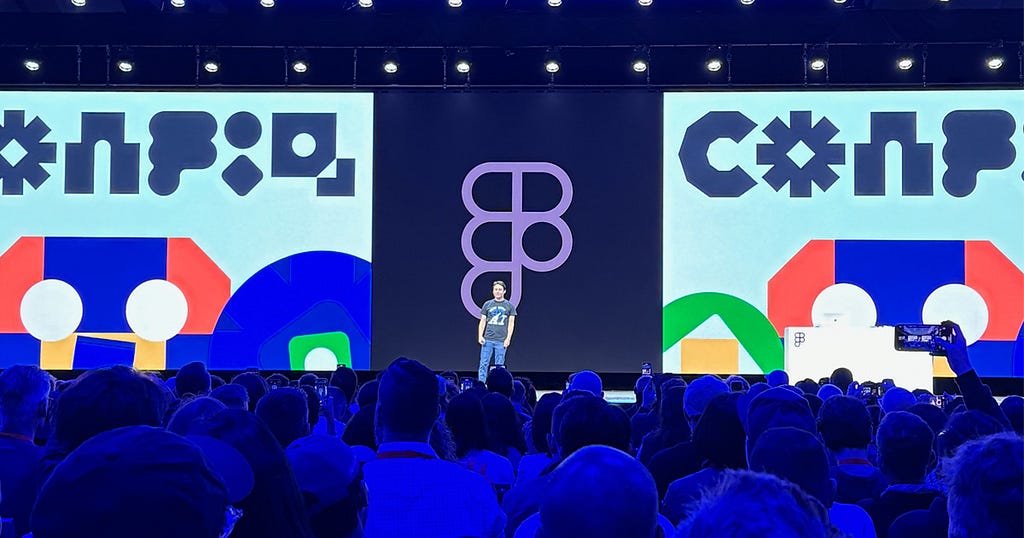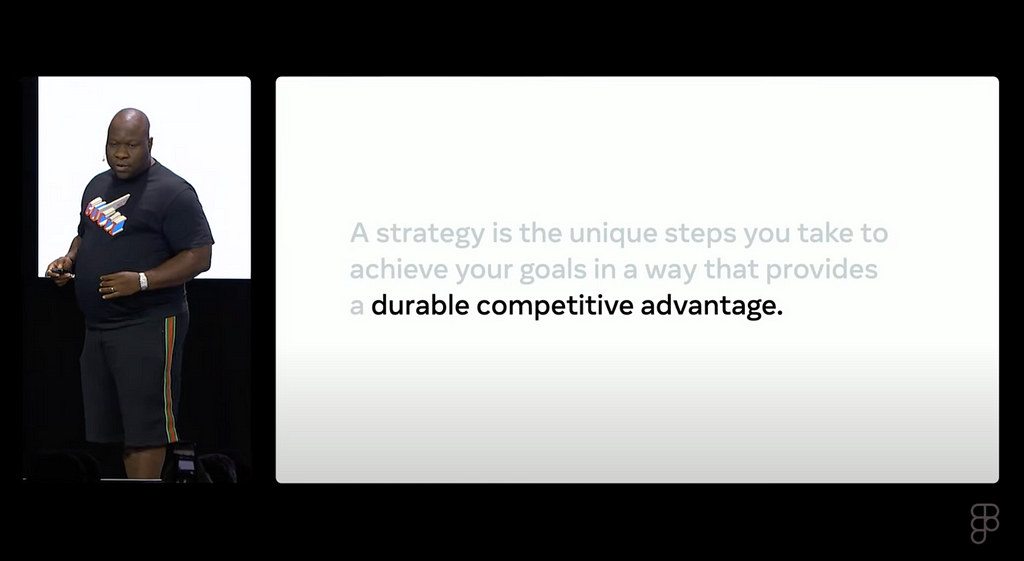What will it take for designers not just to survive but thrive in an era of AI disruption?

I stepped into the jam-packed Moscone Center at Config 2024, eager to glean insights from the design world’s brightest minds. As design leaders from companies like Figma, Meta, Linktree, Zillow, etc. shared some hard-won lessons, a clear theme emerged: our industry stands at a crossroads of challenge and opportunity.
Here are my key takeaways from the talks I attended:
- AI will revolutionize design, but only if we proactively learn to wield it to augment, not replace our creative capacity.
- Features are no longer enough — structural moats like network effects and emotional resonance are equally important for sustainable advantage.
- To win Gen Z, we need to pressure-test long-held beliefs, allow fluid identities, and prioritize authenticity over polish.
- Obsessive attention to craft and a culture of quality are the kindling for design “golden eras.”
Embrace AI to augment, not replace
I’ll be honest, when Figma CEO Dylan Field took the stage and started unveiling a slew of AI features — my heart started racing. Generate designs using a simple text prompt? AI suggestions? One-click prototyping?
The crowd was going wild, cheering and applauding. But me? I was gulping nervously. Don’t get me wrong, part of me was thrilled. As a designer, I couldn’t help but geek out over the sheer potential of these tools. But another part of me couldn’t shake this nagging thought: “Is this what I spent a decade working for? Just for some AI to swoop in and make my skills obsolete?”
I glanced around the auditorium and saw my own anxiety mirrored on countless faces. We were all thinking it, even if we were too scared to say it out loud: Are our jobs on the line? Will designers even be needed in a few years? Honestly, no one knows.

But as I sat through the talks, a different narrative emerged. The overall message from the speakers was one of empowerment, not obsolescence. Figma’s UX writer Ryan Reid encapsulated the sentiment well:
“AI isn’t magic, it’s just a tool. And a tool, by definition, requires a user.” — Ryan Reid
That’s when it clicked for me. The future belongs to designers who can master AI, not be mastered by it. Our value lies not just in our technical skills, but in our creativity, our empathy, and our ability to wield these tools in service of crafting experiences that resonate on a profoundly human level.
So how can we, as designers, start to harness the power of AI while keeping the human touch at the forefront? Here are a few tips that come to mind:
- Experiment with AI to streamline tedious tasks.
- Use AI as a thought partner for brainstorming and analyzing feedback.
- Develop prompt engineering skills to get the most out of AI tools.
The implication: As designers, we need to proactively experiment with AI to augment and accelerate our work, not fear or ignore it — and while doing so, keep humans at the center.
Building moats in an era of “unmet user needs”
But even as AI revolutionizes our tools and workflows, it’s clear that technology alone won’t be enough to secure lasting competitive advantage. Meta’s PM Dare Obasanjo offered a compelling perspective. In today’s saturated market, he argued, features alone no longer cut it. The key to sustainable advantage lies in fulfilling deeper human needs and creating structural barriers to entry — like unique IP (think Sony’s PlayStation games) and network effects (Uber’s driver/rider flywheel).

This is true for Replika’s approach to AI companions. Rather than getting caught up in a features arms race, they’ve focused on cultivating trust and emotional resonance as their key differentiators. Their team discovered that users don’t just want superficial chitchat from their AI — they crave real emotional depth and reciprocal vulnerability from the get-go. Their north star: “Do these interactions make people feel better?”
The lesson: In an era of abundant options, the products that endure will be those that forge genuine emotional bonds — who can tap into the power of brand and community to build moats around their users’ hearts, not just their minds.
Authenticity is key to winning Gen Z
Of course, building those bonds looks different for every generation — and as Linktree’s CPO Jiaona Zhang highlighted, it’s especially tricky when it comes to engaging Gen Z. As the first true “digital natives,” this cohort has grown up immersed in technology, and they bring a whole new set of expectations and behaviors to the table.
While often labeled as “entitled”, this generation prizes immediacy, flexibility, and above all, authenticity. With a low tolerance for friction, they gravitate towards products and experiences that feel raw, real, and relatable from the very first tap. JZ shared examples of how platforms like Notion and TikTok resonate with Gen Z by cutting to the chase, and earning their trust through immediacy.

What this means: To earn Gen Z’s loyalty, radically simplify paths to value, building in opportunities for intimate interaction and self-expression at every turn.
Craftsmanship: The catalyst for design’s golden eras
Perhaps the most inspiring segment came from Zillow’s CDO Jenny Arden, who shared how an obsession with details powered “design golden eras” across companies like Disney, Nike, and Apple. In each case, a relentless focus on craft and quality — often driven by a visionary leader, allowed the team to produce their career-best work.
“For a golden era to happen, three stars need to align: a fundamental change in human need, a sense the company needs its next chapter, and users pining for something new.” — Jenny Arden
Arden’s advice to “master your craft, push what’s possible, obsess over the details” struck me as a timeless principle in an era of rapid technological change. It reinforces my belief that while AI can help us reach “good”, achieving “great” still requires human ingenuity and an unwavering commitment to quality.
As I listened, my mind drifted to a particularly intense project from my early days at Meta. Despite being a small team, we each brought our A-game every single day. Late nights, heated debates, countless iterations — we poured our hearts into every pixel, every line of copy. And when we finally launched, the sense of pride was indescribable.
There’s a certain magic that happens when everyone is deeply invested not just in the outcome, but in the craftsmanship of the process itself. It’s a reminder that even as our tools evolve, the heart of great design remains the same.
The takeaway: While we can’t all be Walt Disney, we can foster a golden era by aligning these elements. As design leaders, this means relentlessly advocating for quality, building a shared sense of purpose, and spotting opportunities for step change innovation.
So what’s next?
Leaving Config, I felt a renewed sense of purpose. The future of design isn’t about pixels, but about people.
And don’t get me wrong — it won’t be easy. The pace of change is dizzying, but the role of designer as a craftsperson is more important than ever. By staying true to the principles of authenticity and user-centricity, I believe this moment can give way to a new era of design — one defined not by the tools we use, but by the depth of meaning we create.
The next golden age awaits. Let’s go make it great!
References
- Reid, R. (2024). Config 2024: Content design and AI: a beginning, not the end [Video]. YouTube. https://www.youtube.com/watch?v=SXdoIIcpc1g
- Obasanjo, D. (2024). Config 2024: Product management: half art, half science, all passion [Video]. YouTube. https://www.youtube.com/watch?v=SZ7AQ9dgPUk
- Zhang, J. (2024). Config 2024: How to build for, and with, Gen Z [Video]. YouTube. https://www.youtube.com/watch?v=-CYpixuRCgU
- Arden, J. (2024). Config 2024: The art of obsession: crafting a culture of excellence [Video]. YouTube. https://www.youtube.com/watch?v=7y9YmZe37A0
If you found value in this article, don’t miss out on more insightful content. Follow me on Medium for regular updates, subscribe to my email updates, or connect with me on LinkedIn for networking opportunities.
What Config 2024 taught me about design’s next golden age was originally published in UX Collective on Medium, where people are continuing the conversation by highlighting and responding to this story.

Leave a Reply